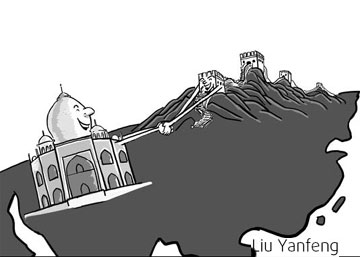Joint partners in transforming the Asian landscape
Updated: 2008-01-18 07:37
Beijing has a way of engaging and cultivating people, especially world leaders. The visit by Indian Prime Minister Manmohan Singh earlier this week was an apt example of China's hospitality, businesslike approach, and diplomatic finesse.
The visit demonstrated extremely warm personal bonhomie, and provided Singh with an opportunity to address more than 600 business leaders. His speech at the China Academy of Social Sciences was broadcast live on CCTV, and heralded a shared vision for the 21st Century. Ten important bilateral agreements and MoUs were also signed.

However, little of substance seems to have emerged from Singh's three-day visit. Compared with the earlier visits to China by Indian prime ministers this one offered the least.
Conversely, this visit was also seen as having instilled new momentum and enthusiasm in China-India relations. It has generated greater confidence and enhanced mutual understanding in the face of rising and lingering suspicions about India's strategic tilt toward the United States.
It seems to have assuaged China's concerns about New Delhi's reluctance on several fronts including a regional trade agreement, allowing China's investments in India and granting China market economy status.
Similarly, China also made gestures of publicizing its understanding and support for India's desire for a greater role at the United Nations and Security Council, in reassuring India of not being an obstacle in the Nuclear Suppliers Group granting a "waiver" for India's nuclear commerce and sharing India's concerns about terrorism and regional security.
The strong chemistry of the two prime ministers emerged the most visible achievement. Premier Wen Jiabao is reported to have stood outside in sub-zero temperatures while waiting for his guest for last Sunday's dinner. Wen had hosted this dinner as a personal gesture that was planned at the last minute, given that weather forecasts had led Singh to arriving earlier than scheduled.
And then, Wen was to compliment Singh for being the most popular among China's Internet users, he put his arm around Singh during the welcome guard of honor at The Great Hall of the People and described Singh as his "elder brother". The mild mannered Singh also managed to win some more friends and admirers among the Chinese.
Like his last formulation on the history of China-India relations being 99 per cent positive and only 1 per cent negative, Wen's new formulation that "we should not ask who will out-do whom" seems to provide a new positive spin to Chindia being partners and not rivals in transforming the landscape of Asia forever.
This sentiment was also echoed by Singh in several of his speeches, and his confidence about China's commitment to cooperation. Unveiling his vision of China-Indian ties, Singh said that both sides should together build "a world of positive externalities and mutual prosperity, rather than one based on balance of power calculations and animosity".
The two sides have pledged to achieve a bilateral trade of $60 billion by 2010. This has to be seen in the backdrop of their trade being less than $2 billion till 1999.
Concerns, however, continued to be expressed with India's rising trade-deficit, its excessive dependence on China in some imports and India's export basket being 50 percent iron ore. However, this rising trade promises gradual rectification of some of these flaws. The juggernaut of Chidia seems irreversible.
The two sides have also agreed to continue with their defense cooperation and are scheduled to hold their next military exercise in India sometime this year. The two have already held two naval and one army anti-terrorism exercise, the last one held in Kunming in December.
Moreover, with the revised new methodology for calculating purchasing power parity by the World Bank, while China remains as the second largest economy in the world, India's position has slipped from third to fifth after the US, China, Japan and Germany.
It is in this larger backdrop that one has to appreciate the two prime ministers signing several documents for cooperation in areas of economic engagement, defense cooperation, anti-terrorism efforts, culture, science, railways, traditional medicine, geological surveys, climate change and energy, including civilian nuclear cooperation.
China clearly shows appreciation of these trends and has promised to address problem areas in Chindia's economic engagement - the strongest pillar of their rapprochement.
China's Commerce Minister Chen Deming, for instance, assured his Indian counterpart to send "buying missions" to India and to discuss removal of technical and non-tariff barriers in sectors like pharmaceuticals, aviation and entertainment to allow India to diversify its export basket and to rectify the rising trade deficit.
Also, keeping with the spirit of Chindia both sides chose to underplay and avoid any public talk of their intractable boundary question which has witnessed a slowdown in the last 18 months.
Talks between the two Special Representatives in evolving their second "Framework" agreement remain lukewarm and their experts group, set up in October 2007 to assist Special Representatives, has still not begun discussions. While multiple drafts have been under discussions the time schedule for exchange of maps has not been fixed. But both sides have agreed not to allow this issue to dwarf their potential in other sectors.
The fact that British prime minister, Gordon Brown, is taking is first foreign tour to China and India perhaps allude to these shifting faultlines of our international system.
The author is associate professor with the School of International Studies, Jawaharlal Nehru University, New Delhi
(China Daily 01/18/2008 page9)
|
|
|
|
|
|